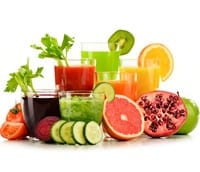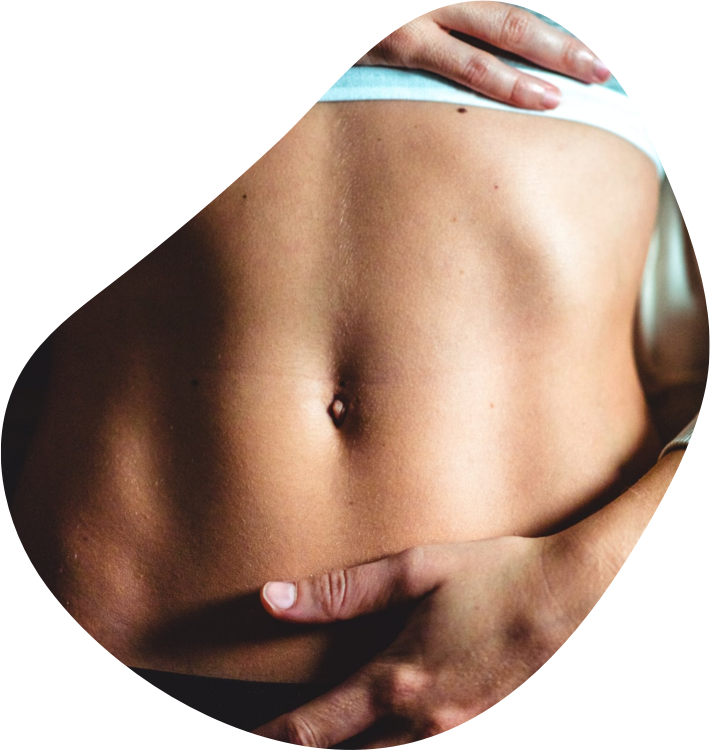Fresh juices introduce a very high yield of nutrients and phytochemicals and they come with their own enzymes for fast assimilation. They also assist those with an impaired digestion where nutrient absorption from whole foods is impaired. Fresh juices can be absorbed directly into your bloodstream so are a fast way to deliver nutrient dense energy. Fresh juice is far superior to store bought juice, which is why having a juicer is beneficial.
Fresh juices contain enzymes that are beneficial for digestion. Juices that are not made fresh, which are bottled or canned will not oxidise. This is because the juice has been heated to deactivate all the enzymes by a process called pasteurisation. Juicing allows you to enjoy a wide variety of vegetables that you may not enjoy eating whole and also a good way to consume the recommended daily serving of vegetables.
There is not one perfect juicer for everyone because fruits and vegetables have vastly different properties. The juicing method that is effective for one may not work while juicing the other. Fruits, have soft cell walls, and therefore require a gentle extraction method. Apples, pears, watermelon, rock melon and pineapple are some of the fruits that can be juiced with the peels intact. Citrus fruits (oranges, grapefruits, mandarines, lemons) have a bitter outer rind, and juicing them whole would be too bitter to drink and also contains indigestible chemicals. You can grate away the outer rind (coloured part) while leaving the pith (white part).
Vegetables have fibrous or tougher cell walls that requiring more mechanical juicing action than fruit. Due to their low acid content, it is recommended that vegetable juices be consumed within 15 minutes of their preparation. It has been demonstrated that enzyme activity in juice 30 minutes old is one-half that of freshly made juice. When apple or carrot juice turns brown, it has oxidised. Ideally juices are made from raw organic fruits and vegetables.
General factors to consider when looking for a juicer
Purpose: What will you be using the juicer for? Mostly fruit, mostly vegetables, grasses and leafy greens, or everything?
RMP rating: A low RMP is considered preferable. Juicers with higher RPM ratings create heat and impact shock, destroying enzyme and nutrient content in the juice.
Powerful motor: A low-powered motor will vibrate, make noise, sometimes overheat, and eventually burn out.
Quiet operation: Some juicers can be very loud depending on the RPM and motor quality.
A range of juicing abilities: It is important to select a juicer that will process the widest range of health-promoting herbs, plants, vegetables and fruits, or is specific for your individual requirements.
Parts: What materials are the components made from? Can they be cleaned in a dishwasher?
Health benefits: Enzyme and nutritional content, shelf life, yield.
Easy to operate: Not all juicers are the same when it comes to ease of operation and cleaning. High RPM juicers need more frequent juicing and cleaning sessions are required because their juice rapidly loses nutritional value and has to be consumed immediately.
Additional benefits to consider: What else can it do? Does it have useful accessories and attachments included? Can it make other things like pasta, nut butters, desserts, baby food etc.? Does it come with a warranty?
Type 1: Twin Gear
These juicers have two gears that press the juice out of the produce. The screws (also known as augers) turn at 90-110 rpm. The produce is pushed into the two gears, which first shreds, and then squeezes the produce. These are best for juicing vegetables since these machines rely on the fibrous cell wall to push the pulp through the machine and they will also juice wheatgrass. These machines require some pressure to feed the produce into the machine. Some brands are also able to homogenise. This is important if you wish to make things like raw apple sauce, fruit sorbets, nut butters, or baby food.
Pros
- Well-suited to juicing leafy greens, grasses, sprouts and herbs
- Higher juice yield
- Juice lasts longer with enzyme integrity keeping for up to 72 hours
- Lower speeds means less heat is generated, preserving more nutrients and enzymes
- Minimal juice separation and foaming
- Some models offer other food processing functions, such as being able to make nut milk, nut butter, sorbet, pasta and ice cream
- Pressing action is quiet.
- Cold pressed juicers extract 35% more juice out of produce
Cons
- Higher initial cost
- Longer food preparation, as smaller food pieces are required for their narrow chutes
- Slightly higher pulp in juice
Type 2: Masticating (single gear)
It operates at lower speed via a masticating or cold press method which doesn’t disrupt cellular structure. This slowness preserves enzymes and nutrients and reduces oxidation. Juice yield is higher than with centrifugal and makes drier expelled pulp.
In contrast to the rough extraction and high speeds of centrifugal juicers, cold press juicers operate at lower speeds and gently compress fruit and vegetables to squeeze out their juice. While more costly, their slower and more thorough extraction rates produce a higher-quality juice, and higher yield. Cold pressed juicers operate at lower speeds (usually around 70-80 rpm), keeping heat generation to a minimum. This produces a better tasting juice with minimal foam and separation and also means that the beneficial enzymes and nutrients are retained.
Pros
- Well-suited to juicing leafy greens, grasses, sprouts and herbs
- Higher juice yield
- Juice lasts longer with enzyme integrity keeping for up to 72 hours
- Lower speeds means less heat is generated, preserving more nutrients and enzymes
- Minimal juice separation and foaming
- Some models offer other food processing functions, such as being able to make nut milk, nut butter, sorbet, pasta and ice cream
- Pressing action is quiet.
- Cold pressed juicers extract 35% more juice
Cons
- Higher initial cost
- Longer food preparation, as smaller food pieces are required for their narrow chutes
- Slightly higher pulp in juice
Type 3: Centrifugal
Centrifugal juicers are commonly available and are the cheapest type to purchase. These machines initially extract juice by pulverising fruit and vegetables against a round cutting blade that spins very quickly against a metal strainer. The centrifugal force generated by the spinning motion of the cutting surface separates the juice from the pulp. It uses a grater or shredder disc and a strainer basket with straight sides to hold the pulp in the machine. The shredder disk is at the bottom of the basket, which revolves at a high speed (3600 rpm). Produce is put into the top of the machine, and it pressed through a chute, hits the spinning shredder disc, while the produce is being shred, juice is released. The basket spins at a high speed and force pushes the juice through the strainer basket and then out of the front of the machine while the pulp stays inside. This style of juicer can make 500ml before the juicer must be stopped, and the pulp must be removed before further juicing can take place. This is not a continuous juicing appliance. This juicer is good for juicing most fruits and vegetables.
Pros
- Fast juicing time
- Cheaper to purchase
- Easy to use
- Reduces food preparation time as many accept larger fruit and vegetable pieces
Cons
- Not well-suited to juicing leafy greens, grasses, sprouts and herbs
- Yields less juice (produces a wet pulp)
- Reduced juice quality due to fast spinning blades producing heat that destroy beneficial enzymes
- Higher juice separation and foaming
- Noisy because of the grinding and cutting action
Additional Information
In between juicing you can run some water through the juicer to rinse it. It is recommended that you rinse and clean your juicer as soon as you’ve finished using it. When you get into a routine of cleaning your juicer it’s quite easy to keep clean and ready to use.
Alkaline forming fruits and vegetables should form the largest part of your juicing produce. Alkaline fruits are: lemon, lime, avocado, tomato, grapefruit, and rhubarb. Watermelon is neutral. All other fruits are acid forming.
Alkaline vegetables are: asparagus, artichokes, cabbage, lettuce, onion, cauliflower, radish, swede, peas, zucchini, red cabbage, leeks, watercress, spinach, turnip, chives, carrot, green beans, beetroot, garlic, celery, grasses (wheat, straw, barley, kamut etc.), cucumber, broccoli, kale, brussels sprouts, sprouts (soy, alfalfa, mung bean, wheat, little radish, chickpea, broccoli etc.).
After regularly consuming freshly pressed vegetable juices, which are highly alkalising, you will experience improved energy levels, digestion and mental clarity, clearer skin, and an overall sense of wellbeing.
Blending and Juicing
The difference between juicing and blending is a juicer extracts juice without the pulp, where a blender blends everything into a purée. Pulp is the fibrous content of the produce which slows down digestion time and is beneficial for the colon microbiota as this feeds the good bacteria which in turn benefits your immune system. Slower digestion time reduces the glycemic index or GI and this is going to be beneficial for diabetic or pre-diabetic conditions.
The fibre or pulp content reduces nutrient absorption however, and requires enzymes to digest it which in turn consumes more energy. Blended foods will also include chemical pesticides unless organic food is sourced. For foods not able to be organically sourced it is best to peel them (particularly waxed fruit or veggies). For root vegetables (e.g. carrots, beetroot) trim the above ground ends and they can be cleansed by blanching prior to juicing (blanching= dropped into boiling water for a minute or so). Blenders use high speed spinning that causes oxidation and can destroy enzymes. They are not the best for high iron content foods that oxidize quickly. Lemon can be added to reduce this but you will need to consider taste.
Juicing produces very high nutrient availability and this promotes healing but may also give healing crisis during juicing detoxes. Detoxification also known as ‘healing crisis’ may be a side effect of juicing for people new to juicing. While for some people this sign of impending good health is wonderful, others may not have the time needed to allow for this process. The process is where old symptoms or patterns of the past may arise transiently or you may experience new symptoms. As healing happens from the inside out, from the top down and from major to minor organs/systems or in reverse order of symptom pattern, you can observe the transition.
To limit or reduce the experience of a healing crisis (for the time challenged) smaller measures are taken over a longer time. You may consider combining your juices into a blender to get benefits of both.
Other important things to remember are to include plenty of water when juicing. Water helps to cleanse and remove wastes from our system. Lemon will loosen and bring out mucus and is good for liver cleansing. Lemon is not acidic to the body, it is alkaline.
Fasting
You may want to consider a juice fast. Fasting causes the liver to convert glycogen stores to glucose and energy. Body fat can be used to ATP but it cannot generate or reform glucose which is needed to supply the brain and central nervous system. Proteins are broken down and used to produce this glucose. In order to prevent protein catabolism, juicing can supply the glucose needed instead. With juice fasting there is less ketosis (byproducts of fat metabolism) which can prevent toxic build up during the fast.
When NOT to fast: pregnant, nursing, underweight, fatigue, low immunity, low blood pressure, colder weather, nutritionally deficient.
Raw foods are very yin and so an excess of this is not recommended for people with excess yin conditions. Ensure in this case to include plenty of cooked warming foods in the diet to balance out the raw food intake. You may use your blender to make purée soups for example.
Certain types of fruits and vegetables can also assist with particular health conditions or be used for target specific organ cleansing.
Fruit juices:
Apple – liver, intestines
Black cherry- colon, menstrual problems, gout
Citrus – cardiovascular disease, obesity, haemorrhoids, varicose veins
Grape – colon, anaemia
Lemon – liver, gall bladder, allergies, asthma, cardiovascular disease, colds
Paw paw – stomach, indigestion, haemorrhoids, colitis
Pear – gall bladder
Pineapple- allergies, arthritis, inflammation, oedema, haemorrhoids
Watermelon – kidneys, oedema
Vegetable juices:
Beetroot – blood, liver, menstrual problems, arthritis
Beetroot greens – gall bladder, liver, osteoporosis
Cabbage – colitis, ulcers
Carrot s- eyes, arthritis, osteoporosis
Celery – kidneys, diabetes, osteoporosis
Comfrey – intestines, hypertension, osteoporosis
Cucumber – oedema, diabetes
Garlic – allergies, colds, hypertension, cardiovascular disease, high fats/high cholesterol, diabetes
Jerusalem artichokes – diabetes
Leafy greens – cardiovascular disease, skin, eczema, digestive problems, obesity, breath
Parsley – kidneys, oedema, arthritis
Potatoes – intestines, ulcer
Radish – liver, high cholesterol, obesity
Spinach – anaemia, eczema
Watercress – anaemia, liver intestines, breath
For weight loss include:
More of: grapefruit, lemon, cucumber, greens, parsley, spinach
Less of: apples, grapes, oranges, carrots
Makensi Caldwell – Certified Bodytalk & Holographics Practitioner, Bachelor of Nutritional Medicine



